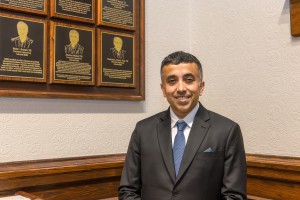 "Great engineering is about solving real problems for real people, not just elegant technical solutions. Stay curious about what problems are worth solving, and you'll never lack for meaningful work."
"Great engineering is about solving real problems for real people, not just elegant technical solutions. Stay curious about what problems are worth solving, and you'll never lack for meaningful work."
For Arindum “Raja” Mukerji ’98, that curiosity—and a drive to understand things at their core—has guided a career defined by innovation and endurance. Raised in a family that encouraged intellectual exploration—a trait further honed at MSOE—Raja turned curiosity into a lifelong pursuit of building systems and industries that last.
Raja's fascination with computers began while growing up in the U.K. At eight years old, his parents gave him one to learn programming, sparking a passion that would define his path. "My path to computer engineering wasn't a sudden epiphany but rather a natural evolution of interests—I was drawn to understanding how systems work and solving complex problems."
After moving with his family from the U.K. to India, Raja completed high school in Kolkata and began his undergraduate studies at the Manipal Institute of Technology. In 1996, he transferred to MSOE as a junior to pursue a computer engineering degree.
At MSOE, he thrived in a curriculum that combined rigor with real-world application. "I wanted a program that would push me technically while giving me practical experience building real systems, not just studying theory. The school's focus on preparing engineers who could immediately contribute to the industry aligned perfectly with my goals."
Long hours in the lab and collaboration on his senior design project helped him form friendships and learn lessons that would shape his leadership philosophy. "I learned that building great technology isn't just about individual brilliance—it's about team resilience and collaboration."
After graduating in 1998, Raja began his career in financial services as a senior engineer at Strong Capital Management. In 2000, he joined F5 Networks as a senior software architect. In this role, he led development of the BIG-IP v9 Traffic Management Operating System (TMOS) with a colleague - a platform so robust that it remains central to F5's infrastructure today. "When F5 recently abandoned their 'next generation' replacement and returned to modernizing TMOS, it validated that sometimes the disciplined, fundamentals-first approach is the right long-term answer."
In 2007, Raja and his F5 colleague became business partners and founded ExtraHop, a cybersecurity company built to deliver real-time network intelligence. "Early in my career at F5, I learned that customers were asking for insights and intelligence, not just faster packet processing. That lesson—to hear the real problem beneath surface requests—directly led to founding ExtraHop."
Today, ExtraHop has become essential infrastructure for enterprise security, helping clients defend against and respond to security threats faster and more efficiently. ExtraHop serves various businesses and organizations across the globe, from government agencies and financial institutions to healthcare systems and retailers.
The company's success attracted investment from Bain Capital and Crosspoint in 2021, which acquired ExtraHop for $900 million, but Raja continues to lead the company as co-founder and chief scientist. "The acquisition was an important milestone that validated our approach to playing the long game. An organization rooted in purpose and aligned in mission to serve society represents an ideal instilled in students by MSOE, and I'm proud to have had the opportunity, privilege, and luck to have realized it."
Throughout his journey, Raja has remained grounded in the belief that enduring success comes from mastering principles, not chasing trends. It's this dedication to foundational understanding and meaningful impact that earned him a place on MSOE's Wall of Distinction.
"I hope my story encourages current students to see that the demanding education they're receiving isn't just about passing courses—it's about developing the capabilities to build technology that matters, to create new categories, and to solve problems that don't have obvious solutions.”
